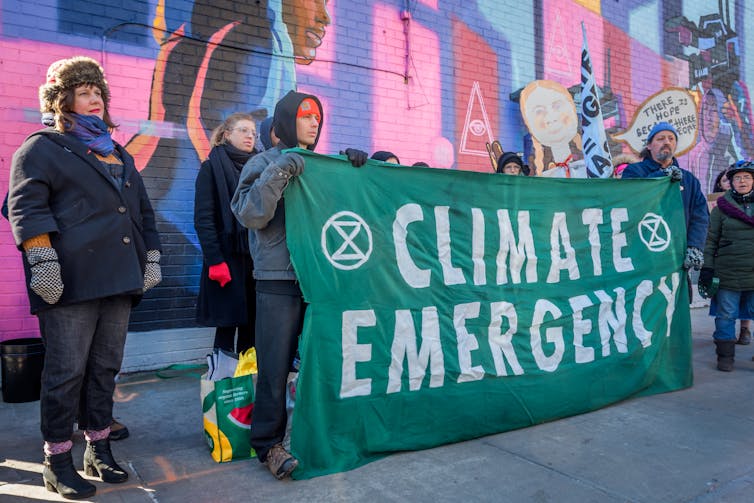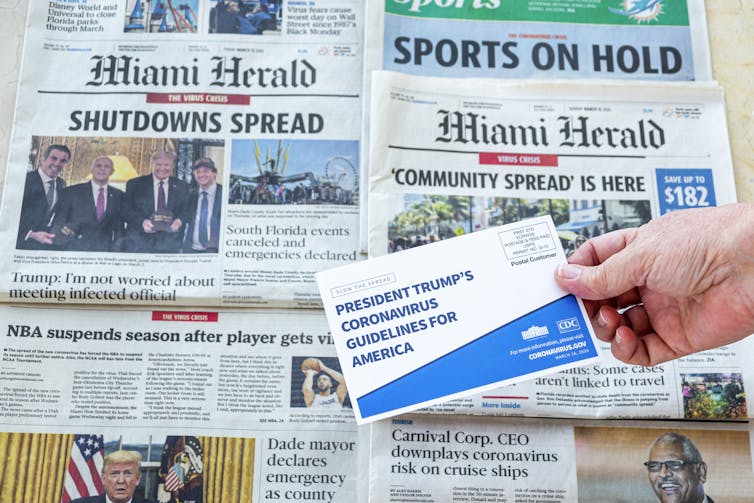Journalists are recognizing they're writing a rough draft of history -- and can't say definitively "
We don't know a whole lot about COVID-19, and journalists are struggling with how to convey the facts we have.

On April 4, a Los Angeles Times story about the varying effects of the novel coronavirus contained a remarkable paragraph:
“One thing to keep in mind before we continue: It is possible that the information you read below will be contradicted in the coming weeks or that gaps in knowledge today will soon be filled as scientists continue to study the virus.”
The paragraph was remarkable because the Los Angeles Times was admitting that its information was incomplete and subject to revision. News organizations, intent on projecting authority and knowledge, rarely admit their fallibility or lack of omniscience.
But in a period of uncertainty and almost constantly changing news, what are the obligations of journalists in making clear that their information is provisional?
News, facts and truth
I teach a course that introduces the history of the American press and examines the “best practices” of journalists. One of the books I use in that class, “The Elements of Journalism,” explores the difference between a fact and truth.
Truth, write authors Bill Kovach and Tom Rosenstiel, is the first obligation of journalists, “yet people are befuddled about what ‘the truth’ means.” Journalists pursue facts and their readers rely on accuracy, which are smaller, related concepts that are easier to measure.

Kovach and Rosenstiel call truth “a complicated and sometimes contradictory phenomenon.” It emerges as facts collect, and each new fact changes a society’s collective understanding of truth. The truth is a snowball rolling down a hill, and each new fact changes the snowball, making it bigger and more multifaceted.
Journalists, however, have historically done a bad job of explaining to the public that each day’s news report is, by necessity, incomplete and provisional. CBS Evening News anchor Walter Cronkite’s famous sign-off, “And that’s the way it is,” sums up the attitude.
The changing conclusions journalists can draw from facts about the coronavirus make the weakness inherent in this attitude especially clear, since information is evolving so rapidly.
The evolving consensus on whether or not to wear masks in public is one example of a part of the coronavirus story that has changed quickly. As New York Times opinion writer Charlie Warzel pointed out, the official advice about wearing masks changed completely in the course of a month.
The question about masks is just one rapidly shifting element among a wide-ranging group of stories whose facts are updated daily, if not hourly. This pandemic is not a one-day story like a press conference or a fire. It is an ongoing story made up of a series of events, public statements, investigative reports, research findings, political decisions and other facts that emerge all the time. Each of these adds to and changes the snowball of truth.
A bias toward events
Long-developing, ongoing stories – such as the coronavirus today – are particularly difficult for journalists to convey in the day-by-day, article-by-article style which they and the public are used to.
With many stories, from climate change to political campaigns to the coronavirus, journalists must rely on expert sources who collect and interpret data and tell the reporters what that data means. These sources change their interpretations, even just slightly, changing the long-term story as more information comes in.
For the public, it is easy to dismiss a story that relies on experts, as well as the growing snowball of the larger story. This is especially true when opponents of a particular policy attack the science, experts and statistics. If the audience does not understand the underlying facts of a story, climate change skeptics or supporters of unproven COVID-19 therapies can present facts that support the outcome they want to support, sowing doubt and confusion.
The problems of uncertainty are particularly troublesome in daily reporting and in the overheated atmosphere of social media, where today’s new development – or new partisan attack – is more important than the big picture.
For that reason, magazines can be a useful place to turn for more nuanced and distanced stories that provide greater context. The Atlantic, for example, has published several stories that put the latest coronavirus-related events into a larger context and explain how the facts work together to form the best understanding of the truth that is available at a given time.
Handling corrections
News organizations, of course, have developed systems for correcting themselves when they are provably wrong about something they have published. As my own research has shown, these systems, however, are something that newsrooms have historically entered into reluctantly.
The New York Times required significant prodding before it began, in 1972, publishing a regular corrections section. Former presidential adviser and future U.S. Senator Daniel Patrick Moynihan first floated the suggestion in an essay in Commentary magazine. The spunky journalism review (MORE) picked up on the suggestion and prodded the Times, which ignored the suggestion until the more respectable Columbia Journalism Review finally persuaded the paper’s editor to institute the practice.
Still, most of the corrections The New York Times publishes are in the nature of a misspelled name rather than about putting facts in the wrong context or explaining how the common understanding of a situation has changed in subtle but important ways.
More recent studies have shown that this focus on correcting fact at the most basic level is true of news organizations in general.
So a corrections column, as much as it suggests a news organization’s dedication to truth, really is not adequate to dealing with uncertain, always changing stories, such as COVID-19.

Engaging with the public
Occasionally a news organization will set up a system of self-criticism, such as The New York Times’ public editor, whose job was to critique the paper from the inside.
Despite the praise given to several of the public editors for pushing the paper to examine its own reporting, The New York Times ended the position in 2017, replacing it instead with a “Reader Center,” which was its new attempt to explain to the public how the news process works, and to give the public a way to engage with the paper.
My research into how that process worked in relation to a controversial profile of a white nationalist that The New York Times published, showed that the results of the effort were, at best, spotty.
I conducted that research guided by the work of a scholar named James Carey. Writing in the 1970s, Carey believed that conversation was the best metaphor for the way that news should work.
I believe Carey’s way of looking at things can inform journalists’ approach to reporting on ongoing stories with uncertain outcomes such as the COVID-19 pandemic or climate change or even a presidential election.
By announcing that its story was immediately subject to revision by new facts, the Los Angeles Times took a major step in that direction and set an example of how to handle such uncertainty.
If the rest of the press likewise acknowledges that today’s truth is not a finished story and audiences begin to demand that sort of transparency, then as trust builds between journalists and the public, a mutual understanding of the facts and, ultimately, the truth can emerge.
[Deep knowledge, daily. Sign up for The Conversation’s newsletter.]
Kevin M. Lerner does not work for, consult, own shares in or receive funding from any company or organization that would benefit from this article, and has disclosed no relevant affiliations beyond their academic appointment.
Read These Next
The Bible says little about Jesus’ childhood – but that didn’t stop medieval Christians from enjoyin
Legends about Jesus’ early years that circulated in medieval Europe often drew on apocryphal texts.
Sleep problems and depression can be a vicious cycle, especially during pregnancy − here’s why it’s
Inadequate sleep can have negative downstream effects on everyday cognitive functioning and mental health,…
Whether Netflix or Paramount buys Warner Bros., entertainment oligopolies are back – bigger and mor
Hollywood has seen this movie before.






